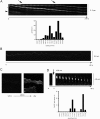Human papillomavirus type 16 entry: retrograde cell surface transport along actin-rich protrusions
- PMID: 18773072
- PMCID: PMC2518865
- DOI: 10.1371/journal.ppat.1000148
Human papillomavirus type 16 entry: retrograde cell surface transport along actin-rich protrusions
Abstract
The lateral mobility of individual, incoming human papillomavirus type 16 pseudoviruses (PsV) bound to live HeLa cells was studied by single particle tracking using fluorescence video microscopy. The trajectories were computationally analyzed in terms of diffusion rate and mode of motion as described by the moment scaling spectrum. Four distinct modes of mobility were seen: confined movement in small zones (30-60 nm in diameter), confined movement with a slow drift, fast random motion with transient confinement, and linear, directed movement for long distances. The directed movement was most prominent on actin-rich cell protrusions such as filopodia or retraction fibres, where the rate was similar to that measured for actin retrograde flow. It was, moreover, sensitive to perturbants of actin retrograde flow such as cytochalasin D, jasplakinolide, and blebbistatin. We found that transport along actin protrusions significantly enhanced HPV-16 infection in sparse tissue culture, cells suggesting a role for in vivo infection of basal keratinocytes during wound healing.
Conflict of interest statement
The authors have declared that no competing interests exist.
Figures






Similar articles
-
Single-particle tracking of murine polyoma virus-like particles on live cells and artificial membranes.Proc Natl Acad Sci U S A. 2005 Oct 18;102(42):15110-5. doi: 10.1073/pnas.0504407102. Epub 2005 Oct 11. Proc Natl Acad Sci U S A. 2005. PMID: 16219700 Free PMC article.
-
HPV caught in the tetraspanin web?Med Microbiol Immunol. 2020 Aug;209(4):447-459. doi: 10.1007/s00430-020-00683-1. Epub 2020 Jun 13. Med Microbiol Immunol. 2020. PMID: 32535702 Free PMC article.
-
Human Papillomavirus 16 Infection Induces VAP-Dependent Endosomal Tubulation.J Virol. 2018 Feb 26;92(6):e01514-17. doi: 10.1128/JVI.01514-17. Print 2018 Mar 15. J Virol. 2018. PMID: 29321327 Free PMC article.
-
IRSp53: crossing the road of membrane and actin dynamics in the formation of membrane protrusions.Trends Cell Biol. 2008 Feb;18(2):52-60. doi: 10.1016/j.tcb.2007.12.002. Epub 2008 Jan 22. Trends Cell Biol. 2008. PMID: 18215522 Review.
-
Virus movements on the plasma membrane support infection and transmission between cells.PLoS Pathog. 2009 Nov;5(11):e1000621. doi: 10.1371/journal.ppat.1000621. Epub 2009 Nov 26. PLoS Pathog. 2009. PMID: 19956678 Free PMC article. Review.
Cited by
-
Anal warts and anal intradermal neoplasia.Clin Colon Rectal Surg. 2011 Mar;24(1):31-8. doi: 10.1055/s-0031-1272821. Clin Colon Rectal Surg. 2011. PMID: 22379403 Free PMC article.
-
Motion analysis of live objects by super-resolution fluorescence microscopy.Comput Math Methods Med. 2012;2012:859398. doi: 10.1155/2012/859398. Epub 2011 Nov 17. Comput Math Methods Med. 2012. PMID: 22162725 Free PMC article. Review.
-
Imaging, Tracking and Computational Analyses of Virus Entry and Egress with the Cytoskeleton.Viruses. 2018 Mar 31;10(4):166. doi: 10.3390/v10040166. Viruses. 2018. PMID: 29614729 Free PMC article. Review.
-
Influenza entry pathways in polarized MDCK cells.Biochem Biophys Res Commun. 2014 Jul 18;450(1):234-9. doi: 10.1016/j.bbrc.2014.05.095. Epub 2014 May 27. Biochem Biophys Res Commun. 2014. PMID: 24878525 Free PMC article.
-
RNA interference and single particle tracking analysis of hepatitis C virus endocytosis.PLoS Pathog. 2009 Dec;5(12):e1000702. doi: 10.1371/journal.ppat.1000702. Epub 2009 Dec 24. PLoS Pathog. 2009. PMID: 20041214 Free PMC article.
References
-
- Roberts JN, Buck CB, Thompson CD, Kines R, Bernardo M, et al. Genital transmission of HPV in a mouse model is potentiated by nonoxynol-9 and inhibited by carrageenan. Nat Med. 2007;13:857–861. - PubMed
Publication types
MeSH terms
Substances
LinkOut - more resources
Full Text Sources

